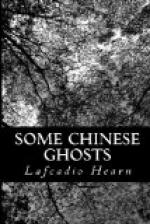FUH-YIN.—An official holding in Chinese cities a position corresponding to that of mayor in the Occident.
FUNG-HOANG.—This allegorical bird, corresponding to the Arabian phoenix in some respects, is described as being five cubits high, having feathers of five different colors, and singing in five modulations.... The female is said to sing in imperfect tones; the male in perfect tones. The fung-hoang figures largely in Chinese musical myths and legends.
GOPIA (or GOPIS).—Daughters and wives of the cowherds of Vrindavana, among whom Krishna was brought up after his incarnation as the eighth avatar of Vishnu. Krishna’s amours with the shepherdesses, or Gopia, form the subject of various celebrated mystical writings, especially the Prem-Sagar, or “Ocean of Love” (translated by Eastwick and by others); and the sensuous Gita-Govinda of the Bengalese lyric poet Jayadeva (translated into French prose by Hippolyte Fauche, and chastely rendered into English verse by Edwin Arnold in the “Indian Song of Songs"). See also Burnouf’s partial translation of the Bhagavata Parana, and Theodore Pavie’s “Krichna et sa doctrine.” ... The same theme has inspired some of the strangest productions of Hindoo art: for examples, see plates 65 and 66 of Moor’s “Hindoo Pantheon” (edition of 1861). For accounts of the erotic mysticism connected with the worship of Krishna and the Gopia, the reader may also be referred to authorities cited in Barth’s “Religions of India”; De Tassy’s “Chants populaires de l’Inde”; and Lamairesse’s “Poesies populaires du Sud de l’Inde.”
HAO-KHIEOU-TCHOUAN.—This celebrated Chinese novel was translated into French by M. Guillard d’Arcy in 1842, and appeared under the title, “Hao-Khieou-Tchouan; ou, La Femme Accomplie.” The first translation of the romance into any European tongue was a Portuguese rendering; and the English version of Percy is based upon the Portuguese text. The work is rich in poetical quotations.
HEI-SONG-CHE-TCHOO.—“One day when the Emperor Hiuan-tsong of the Thang dynasty,” says the Tao-kia-ping-yu-che, “was at work in his study, a tiny Taoist priest, no bigger than a fly, rose out of the inkstand lying upon his table, and said to him: ’I am the Genius of ink; my name is Hei-song-che-tchoo [Envoy of the Black Fir]; and I have come to tell you that whenever a true sage shall sit down to write, the Twelve Divinities of Ink [Long-pinn] will appear upon the surface of the ink he uses.’” See “L’Encre de Chine,” by Maurice Jametel. Paris. 1882.
HOA-TCHAO.—The “Birthday of a Hundred Flowers” falls upon the fifteenth of the second spring-moon.
JADE.—Jade, or nephrite, a variety of jasper,—called by the Chinese yuh,—has always been highly valued by them as artistic material.... In the “Book of Rewards and Punishments,” there is a curious legend to the effect that Confucius, after the completion of his Hiao-King ("Book of Filial Piety"), having addressed himself to Heaven, a crimson rainbow fell from the sky, and changed itself at his feet into a piece of yellow jade. See Stanislas Julien’s translation, p. 495.




